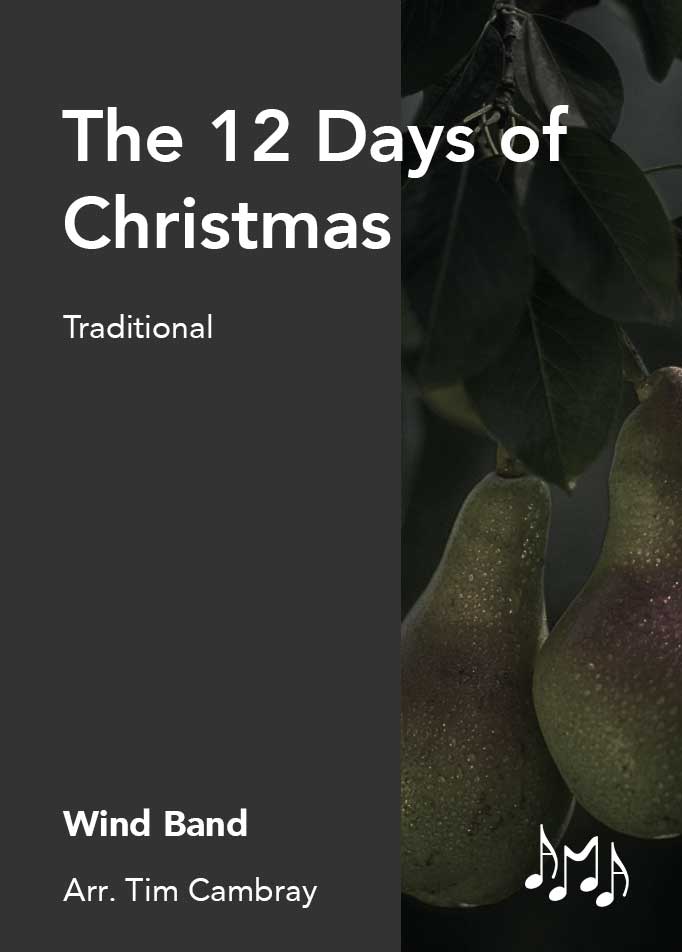The 12 Days of Christmas
| Length | 4 mins 12 secs |
|---|---|
| Composer | Trad. arr. Tim Cambray |
| Parts | Piccolo, principal flute and 2 other flutes, oboe, cor anglais, 2 bassoons, principal clarinet and 3 other clarinets, bass clarinet, 2 alto saxes, tenor sax and baritone sax, 2 horns,. principal trumpet and 3 other trumpets, 2 trombones, bass trombone, euphonium and tuba, timps, bass drum, side drum, cymbals, tambourine and triangle, glockenspiel, xylophone, voice (with words), string bass. |
| ISBN | 978-1-915957-07-8 |
£30.00
There are vague references to Christmas counting songs going back beyond Medieval times. The first recognised writing down of this song appears in 1780, in a children’s book, “Mirth without Mischief”, under the title, ‘The twelve days of Christmas sung at King Pepin’s ball’. There have been many versions since, some most irreverent. There is even a reference to a version by Douglas Adams (he of ‘The Hitch Hiker’s Guide to the Galaxy’ fame). One website points out (with its tongue firmly placed in its cheek) how many of each item you would get by the 12th day. 12 patridges and 12 drummers, 22 turtle doves and pipers, 30 French hens and Lords, and so on ariving at 42 Geese and Swans. So the song therefore contains the Meaning of Life, the Universe and Everything, 42. Then which words to use? There seems to be general agreement about the ‘Partridge in a Pear tree’ although one reference is to a ‘pretty peacock on a pear tree’. This does not scan too well. How about ‘4 calling birds’ or is it ‘4 mocking birds’, ‘4 colly birds’ or ‘coloured birds’ or even ‘canary birds’? (Colly is old English for coloured or black so perhaps we should sing ‘4 black birds’?) Do you sing, ‘5 gold rings’ or ‘5 golden rings’? ‘6 geese or is it ducks a laying’? ‘7 swans a swimming’ or possibly ‘7 squabs a swimming’ (a Squab is a young fledgling pigeon or a short fat person). What about ‘8 maids a milking’ or ‘8 Maids a waiting’. Perhaps even ‘8 hares a running’ or ‘8 hounds a running’. 9, 10, 11 and 12 are in sorts of orders as well as the most familiar one. You could have ‘9 bears a beating’ (probably not), ’10 cocks a crowing’, ’10 ships a sailing’, ’11 lads a louping’ (to leap or jump over or into something) or the risky ’11 badgers baiting’, and lastly ’12 bells a ringing’. Then which tune? There is the well known one by Frederick Austin, another from an old carol book or one from the folk music collector Cecil Sharp (known to his friends as C sharp). In the end, all three have been used.Frederic’s Austin’s 1909 version uses the now familiar tune and he also settled on the words most usually used. Here they are with the tune number and order used in this arrangement.
A partridge in a pear tree tune 1 7 swans a swimming tune 2
2 turtle doves 2 8 maids a milking 3
3 French hens 3 9 ladies dancing 1
4 calling birds 2 10 lords a leaping 2
5 gold rings 1 11 pipers piping 3
6 geese a laying 1 12 drummers drumming 1
Before the main score of the piece, there are the three themes that make up this arragement. In performance, it is suggested that the conductor explains the piece to the audience so they can ‘sing along’. Then gets the three themes played individually scored on three different instruments.
All musical arrangements are available to download as PDFs.
Once purchased, your files can be downloaded from Your Account.





